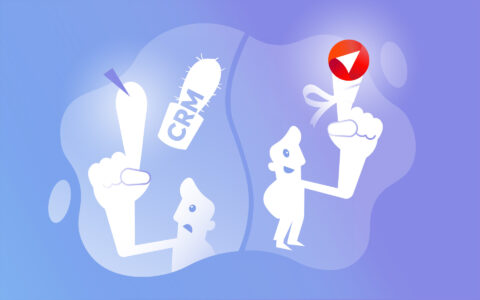Does your current CRM system not meet your needs and expectations? Never mind, just look for a new CRM software. The CRM replacement process is not a breeze, but if you follow the procedure below, everything should be fine.

When companies buy a CRM for the first time, they often don't know what to expect from it. You can consider it a success when employees get used to the new system, and the first CRM will help you organize contacts and sales. However, many companies will eventually become interested in furthering their use of the CRM. Making the experience with a second CRM way more interesting.
Motivation for change
If CRM users are happy with the system, then companies are usually motivated to replace the CRM by the fact that the software does not meet their increasing demands. What limits can hold you back? And is there a solution other than the replacement of a CRM software in these cases?
Custom-built CRM software
Do you know exactly what to expect from a CRM? Then a custom CRM software development should suit your business needs. But the development costs will be many times higher than the price of an off the shelf CRM software. Plus, after a few years, it usually turns out that the custom-built software itself is not as flexible as the commercial one, which is constantly evolving. Unfortunately, the necessary software improvements cannot be solved other than by the additional development of new features. Upgrading your own system can then be much more expensive than acquiring a new CRM.
Technical limits
If a company chooses a CRM in the market, unlike custom-made applications, they will never have absolute control over the development of the purchased system. When a company encounters technical limits, there is usually no choice but to replace a CRM software. This happens, for example, when a company needs to move from a cloud solution to its own server and the CRM provider does not offer this option. Or, when users are missing some feature and they solve the problem through non-standard procedures.
The future potential of the software
As the company grows, so should the CRM system it uses. Small start-ups especially like to start by using a CRM for marketing or as a project management tool, in addition to contact and sales management. Or they want to integrate the system with accounting and other software. A CRM with the greatest potential can help you automate a lot of business processes. If the new feature you want is really important, it is high time to look for a new CRM.
Choosing the right CRM
Is a CRM replacement the best solution in your situation? Choose a new software carefully so that you do not soon find yourself in the same situation again. The process of choosing a suitable CRM is slightly different in each company, but the following steps should always lead you to your goal.
CRM selection team
Before choosing a specific CRM, it is important to pull together a CRM selection team. In addition to the management representative and the project manager who will be in charge of the implementation, it should also include representatives of each department that will work with the CRM.
CRM software requirements
Before choosing a CRM software, it is crucial to set a price limit and write a list of requirements for the new software. The reasons for the CRM replacement should appear among the must-have requirements. Members of the implementation team who have user experience with the previous CRM should help the project manager with this.
Shortlist
Do you have a list of requirements for a new CRM? Then you can start looking for systems that meet your requirements. You can search on Google of course, professional servers such as Capterra or user recommendations on LinkedIn are also popular. A lot of CRMs also offer a free demo to introduce the software to those interested in a short period of time.
Testing and shortlisting
Many CRMs usually offer the option of a free trial period. Be sure to take advantage of this and download the software that meets your requirements and test the CRM usage scenarios with the representatives of the individual departments. Especially the areas that the previous CRM did not meet needs or expectations. Of course, it is also important whether the software is user-friendly. After proper testing, you will probably agree on the two to three hottest adepts.
Final conclusion
Then the company's management may consider the possible nice-to-have requirements for the future and choose one of the shortlisted CRMs. Once the final decision is made, you can start implementing a new CRM.
Setting up the new software
The new software needs to be set up and adapted to the needs of the company. In addition to the basic settings, more advanced features are being set up, such as connecting the CRM to other company softwares or customizing the user environment and creating your own user fields.
When users do not have a clearly defined field for a particular type of information, they usually start filling in the comments field and other irrelevant fields. It is then almost impossible to find this information or use it in reports. The feature of customized fields therefore often appears among the must-have requirements for new CRMs.
Data migration
When replacing a CRM software, it is crucial to correctly transfer data from the existing CRM to the new software. Data migration is usually the biggest challenge of implementing a new CRM. At the same time, it is a good opportunity to clean up company data, as no one usually wants to do regular maintenance.
To start in a new CRM with a clean database, go through the records and set the parameters to filter the data that will be transferred to the new CRM. For example, you can transfer just the contacts with whom you communicated with a maximum of three years ago. Without historical contacts, the new CRM will definitely be clearer. Similarly, you can set parameters for the data migration of sales, projects, tasks and other modules.
The data migration itself is usually performed by representatives of the new CRM. Some companies may use their own IT specialists. In both cases, it is necessary to perceive the differences between the existing and the new CRM in terms of data structure. For example, some CRMs have contacts and companies in one module together, and others separately. Due to such differences, it is always necessary to take a unique approach to data migration. If the migration is performed by a new CRM representative, they usually contact the company first to find out how they work with the existing CRM and to plan how the data will be migrated.
Users must not use the old CRM during migration to avoid data errors. Therefore, companies often forbid the use of the CRM for several hours during the migration.
Testing
Once the data is transferred, it is time for regular users to test the quality of the data in the new CRM. It is advisable to approach testing both randomly and systematically. For example, checking the total number of records transferred. If the data is converted incorrectly or some data is missing, the developer who performs the data migration analyzes the cause of the error and prepares a migration fix. Until then, users can switch to the old CRM. When the data migration fix is ready, follow the same procedure.
In addition to data quality check, a standard test phase takes place during which users test all operations and send feedback so that all errors can be debugged.
Go live
When the company starts using the new CRM, the user training is important. They have a user experience with a previous CRM software. However, some processes change with the replacement. Training, documentation and video instructions for employees help the company set up the right way to work with the CRM software.
A CRM replacement project is not something to worry about. Compared to the implementation of the first CRM, data migration can be a bit challenging. On the other hand, the experience with the previous CRM is priceless when choosing a new software.











